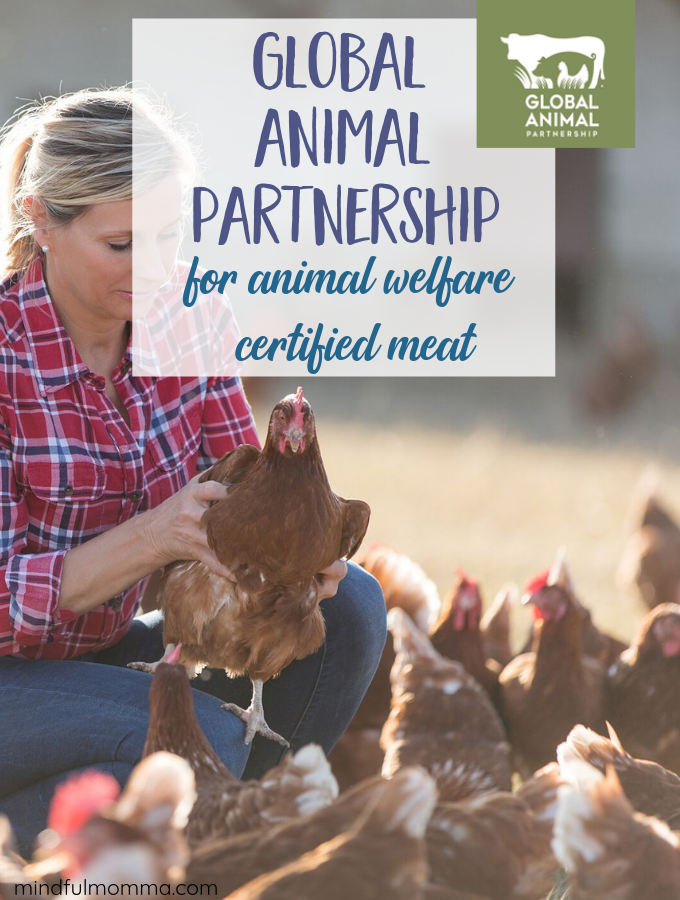How Global Animal Partnership’s Animal Welfare Certification Program Can Help You Buy Better Meat
Learn about the Global Animal Partnership 5-Step® Animal Welfare Certification Program so you can feel confident that the meat you buy comes from animals that have been raised following comprehensive standards focused on their care and welfare.

Thank you to Global Animal Partnership for sponsoring this post.
Over the many years that I’ve been on a journey to live a more green & healthy lifestyle and to be a more conscious consumer, some things have come easily and others have been a bit more challenging to navigate. One of those more challenging areas has been buying meat. When you look at a typical package of meat in a grocery store, you may see a variety of claims like “fresh”, “all natural” or “humanely raised”, but those claims on their own mean nothing. A variety of certifications for meat products exist, but many do not adequately address the welfare of farm animals or require audits of every farm. It can be tricky to find a certification you can trust.
That’s why I want to introduce you to a certification called Global Animal Partnership or GAP for short. GAP has been around for a while, but only recently came to my attention. Now that I know to look for GAP animal welfare certified products, I feel confident that the meat I am buying has been raised and produced in an ethical matter with the welfare of the animals in mind.
Let’s take a closer look at Global Animal Partnership and the certifications they offer:






Thank you to Global Animal Partnership for sponsoring this post.
Over the many years that I’ve been on a journey to live a more green & healthy lifestyle and to be a more conscious consumer, some things have come easily and others have been a bit more challenging to navigate. One of those more challenging areas has been buying meat. When you look at a typical package of meat in a grocery store, you may see a variety of claims like “fresh”, “all natural” or “humanely raised”, but those claims on their own mean nothing. A variety of certifications for meat products exist, but many do not adequately address the welfare of farm animals or require audits of every farm. It can be tricky to find a certification you can trust.
I may receive commissions from purchases made through links in this article including Amazon Affiliates. Full Disclosure
What is Global Animal Partnership?
Global Animal Partnership (GAP) is one of the largest animal welfare certification labeling programs in North America. They set the standard for how farm animals are raised – positively impacting 416 million farm animals each year through their 5-Step® Animal Welfare Certification Program. Their labels provide consumers an easy way to identify how animals were raised while also allowing for continuous improvement on-farm. GAP ensures their farm animal welfare standards are being met on every farm – not just a sample. This level of detail is important so when consumers see the GAP label, they can feel good about the meat they eat. The certification program that Global Animal Partnership created is the 5-Step® Animal Welfare Certification Program that includes specific standards for each species of animal for beef, bison, chicken, goat, laying hens, pigs, sheep, and turkey.
Photo source: Thompson Farms
The GAP 5-Step Animal Welfare Rating Program
GAP’s 5-Step Animal Welfare Rating Program is extremely rigorous and involves collaborative input from farmers, scientists, veterinarians, industry experts and certifiers along the way.
Some more details about the 5-Step Animal Welfare Rating Program:
Since every species has different needs, GAP standards are customized for each animal type. Standards currently include beef, chickens, turkey, pigs, sheep, goats, bison and laying hens.
Animal agriculture is complicated and I’m super impressed with how they lay out the basics of each level for the average consumer to understand. If you visit the GAP website, you’ll see that they are very transparent and offer links to their standards in specific detail.
To help people like us who don’t spend much time on a farm, they put together helpful information detailing the program steps from Step 1 to Step 5+. See the detailed standards for chicken here.
- Animal welfare is defined by considering the health and productivity of the animal, natural behaviors, and the emotional well-being of the animal.
- Every single farm is audited every 15 months (unlike some certification programs that only audit a percentage of farms)
- Audits are done by independent firms and though different seasons.
- All standards are field tested on a farm before being approved.
- Based on the results of the audit, the farm or ranch will earn a Step Rating of 1 through 5+.

GAP 5-Step Animal Welfare Rating Labels
To bring these standards to the marketplace, GAP created a 5-Step Animal Welfare Certification Program for GAP Certified products that reflects the ratings. GAP Certified products can be found in stores throughout North America. When you see the GAP Certified label, you can feel confident that the animals have been raised following comprehensive standards focused on their care and welfare.
The website provides considerable details about each step if you want to dig in, but here are the basic standards for each step:
At Whole Foods Market, you’ll see information about all 5 steps behind the meat counter. It’s a convenient way to be reminded of what each step means.
- Step 1 – Base level certification
- Step 2 – Enriched environment – like straw bales for chickens or shade structures & scratching posts for cattle
- Step 3 – Outdoor access – animals able to go outdoors
- Step 4 – Pasture raised – access to pasture and the outdoors all year round
- Step 5 – Animal centered – always on pasture and no physical alterations permitted
- Step 5+ – Entire life on the same farm

Brands that Use GAP 5-Step Animal Welfare Rating Labels
GAP certification can be found on raw meat, cooked meat like sausages and deli meat, chicken broth and even pet food. Certifications for dairy and farmed salmon are in the works.
The GAP Certified labels have been in use at Whole Foods for their 365 brand for over a decade. Other brands that are GAP Certified include:
Visit the GAP website to see all brands and products available.
And if you’re curious what a GAP certified farm is like, have a look at GAP’s new blog post series called #GAPFarmLife, where they show consumers some of their program in action.
Depending on where the information comes from, farming is painted in either an exceptionally negative or exceptionally positive light. You’ve probably become used to seeing either animals piled in cages on top of each other, or cows dotted along a pasture on a bright, sunny day with daisies in the foreground. It’s hard to know what normal looks like when you’ve only been given two extremes.
That’s why GAP created its GAP Farm Life blog series. GAP thinks consumers deserve to know what farmers and ranchers do day-in and day-out to take care of animals certified to the GAP animal welfare standards. After all, in order to trust our label, you need to understand the process. See the #GAPFarmLife blog posts here and search the hashtag on social media.
Hopefully this explanation of GAP certification will help you buy meat for your family with confidence! If you have any further questions, we’ll be happy to answer them in the comments.
- Applegate (lunchmeat and sausages)
- Bilinski’s (sausages)
- Wellshire Farms
- La Quercia (proscuitto)
- Naked Truth (frozen chicken)
- Western Grassfed Beef (hot dogs)
- Atkin’s Ranch
- Nature’s Rancher
- Panorama Meats (beef)
- Tender & True (pet food)




I was hoping to see a comparison of GAP to other programs.
This post was meant to be a general overview of the GAP program. Feel free to contact them to ask more specific questions: [email protected]